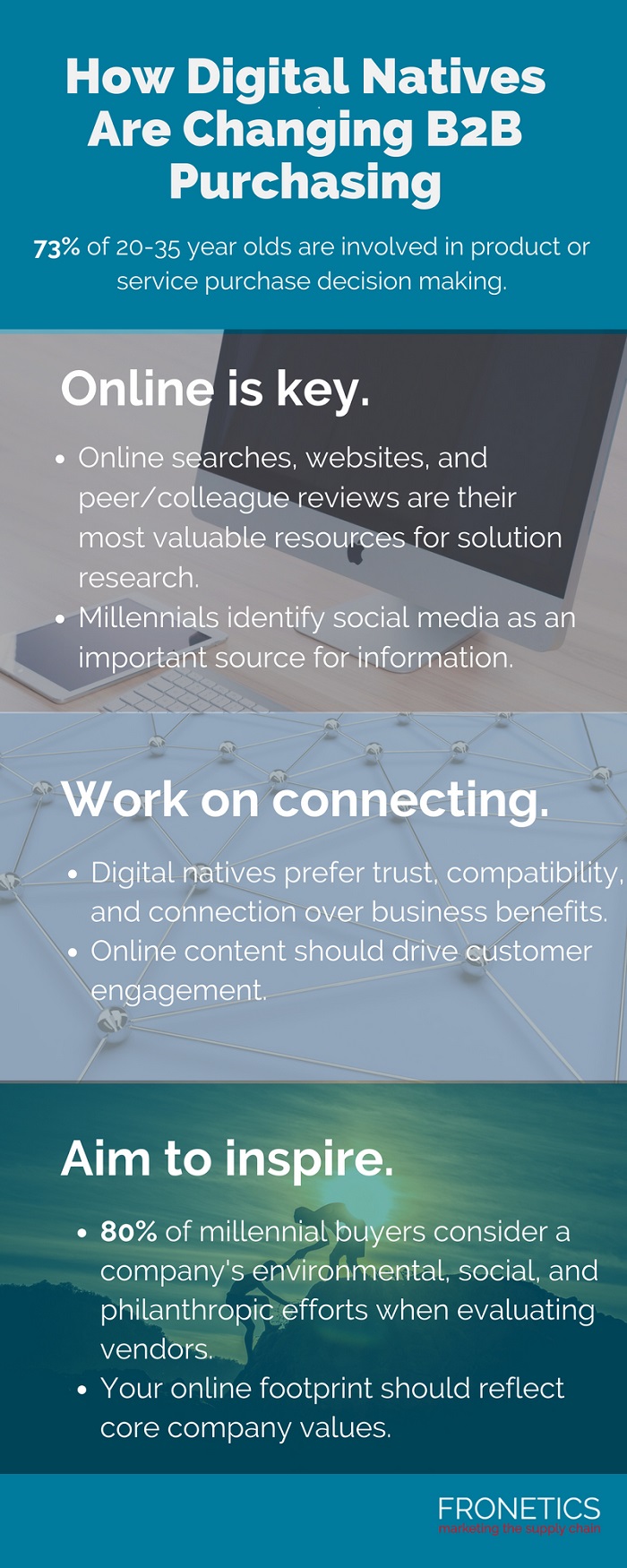
by Fronetics | Sep 17, 2018 | Blog, Content Marketing, Logistics, Marketing, Social Media, Strategy, Supply Chain
Today’s B2B buyers are mostly digital natives who get the majority of their purchasing information from online searches, vendor websites, and peer recommendations.
From a content marketing perspective, knowing where your buyers get their information is critical to an effective strategy. So what are most important sources of information for today’s B2B buyers? 20 years ago, you might have named things like product info sheets or sales reps. But not anymore.
B2B buying has completely evolved, thanks in large part to the increasing percentage of digital natives who now make up the B2B purchasing landscape.
Is your content marketing strategy meeting buyers where they are? Here are the three most important sources of information for B2B buyers.
3 top sources of information for B2B buyers
1. Online search
Not only is an online search the first move for 62% of B2B buyers, 94% of buyers report using online research at some point during the purchasing process. And this isn’t a surprise, when you consider that, according to a study of millennial buyers by Merit, “some 73% of 20 to 35 year olds are involved in product or service purchase decision-making at their companies.”
[bctt tweet=”Not only is an online search the first move for 62% of B2B buyers, 94% of buyers report using online research at some point during the purchasing process.” username=”Fronetics”]
So what does this mean for your business? Gone are the days when a simply thinking about keyword rankings was enough to boost your SEO. In our four-part series on writing for SEO, we address how search engines and the search landscape have changed over the past several years. Improving your search ranking can seem like a complex process, but in the end it all boils down to one thing: quality content, presented in a clear and compelling manner.
2. Vendor websites
So buyers conduct their online search. And if you’ve done your content marketing homework, they find your business. How does your website stack up?
According to Bain’s global customer insights chief Eric Almquist, by the time they reach your website, buyers “will have already formed a strong opinion about many aspects of the value expected from a vendor.” For this reason, your website should “provide a wealth of information on these types of value, with details on where… products have been successful.”
Your website should be one of your primary assets. If you don’t give visitors plenty of easy, attractive opportunities to convert on your website, content marketing won’t generate leads for you. Your content should be organized and clear, presented with the goal of helping your potential customers. And opportunities for conversion should be everywhere.
3. Peers and colleagues
As digital natives step into purchasing roles in the supply chain, they’ve “brought their consumer habits to the B2B world,” says Almquist. This means that a big part of the purchasing process involves review sites, where purchasers seek the opinion of their peers and colleagues. “Reviews will tell the buyer how a vendor performs on many ease-of-doing-business elements long before the buyer has actual experience with that vendor.”
This aspect of content marketing can seem daunting for many businesses because of the perception that what’s on these sites is completely out of your control. But with the right strategy in place, review sites are actually a big opportunity for your business.
For a start, vendors “should encourage customers who are advocates of the company to provide reviews on relevant sites.” It’s also important to take an active role on these sites, responding to customer reviews — even the occasionally inevitable bad ones.
Says Almquist, “First impressions matter as much as ever in B2B markets. Today though, that first look comes through websites, user forums, and quick case studies, not flesh-and-blood sales pitches.”
With a well-thought-out, data driven content marketing strategy, you’ll be ready to meet digital natives where they are.
What sources of information for B2B buyers do you focus on?
Related posts:


by Fronetics | Sep 13, 2018 | Blog, Content Marketing, Logistics, Marketing, Supply Chain
When sales and marketing misalignment plagues your organization, it can have motivational and financial consequences.
Imagine your business spending millions of dollars trying to fix one perceived problem — and it wasn’t even the problem, after all.
Too often, B2B companies fall victim to the dangers of sales and marketing misalignment, often without even being aware that it’s an issue. In fact, a recent study by HubSpot found that only 22% of companies report that their sales and marketing relationship is tightly aligned.
[bctt tweet=”HubSpot found that only 22% of companies report that their sales and marketing relationship is tightly aligned.” username=”Fronetics”]
That’s a big problem. And, recently, four business and marketing professors set out to explore just how bad it is for companies when sales and marketing don’t line up. In a recent article in the Harvard Business Review, Wendy Ritz, Michelle D. Stewart, Felicia N. Morgan, and Joseph F. Hair, Jr., described their findings from an experiment and interviews, designed to tackle the issue of sales and marketing misalignment, specifically in regard to the pricing of products and sales initiatives.
What’s wrong with sales and marketing misalignment?
The researchers identified three major dangers for businesses when sales and marketing don’t share goals.
Danger 1: Demotivation
A key part of motivation is the belief that a team can achieve its goal. When goals are misaligned, “it reduces the sales force’s perception that they can achieve either goal.”
In turn, the researchers point out that this demoralizing effect can reduce commitment to the organization, in addition to specific goals. In their experiment, they found that “the effect of misaligned goals reduced hope of the salespeople and created a defeatist climate.”
Danger 2: Goals seem insurmountable
Again, the perception that goals can be achieved is crucial. When sales and marketing are misaligned, people are much more likely to view goals as more difficult or even impossible to achieve.
The researchers point out that “while difficult goals are not necessarily problematic, the challenge is when the sales force believes that the misalignment of goals is simply unnecessary, or that the goal combination makes it impossible to be successful.” In other words, if goals don’t line up, you wind up with a sales force who feels defeated immediately.
Danger 3: It’s going to cost you
Remember the old adage, “Be careful what you wish for?” When it comes to sales and marketing misalignment, the highest cost often comes when goals are met.
“To compensate for the mismatch between pricing and sales force compensation goals,” the researchers found, “salespeople may offer additional resources such as free training, free freight, and customized products.” When goals seem insurmountable or counterproductive, sales teams find themselves resorting to desperate measures to get the job done — which can unnecessarily erode profits.
When things go right
According to a recent study by Data Room and Marketo, “Sales and marketing alignment can improve sales efforts at closing deals by 67% and help marketing generate 209% more value from their efforts.”
The survey found that sales teams closely aligned with their marketing counterparts ranked the quality of marketing-sourced leads much higher than those that were rarely aligned or misaligned. The bottom line: sales and marketing teams that are aligned perform better.
Thinking about getting your sales and marketing on the same page? Consider these six ways to boost sales and marketing alignment.
Related posts:


by Fronetics | Sep 12, 2018 | Blog, Content Marketing, Logistics, Marketing, Strategy, Supply Chain
Here are the top three resources digital natives are using to research solutions and how your B2B business can prepare to meet them online.
Knowing where your buyers do research when making purchasing decisions is crucial to any marketing strategy. Digital natives, a new generation of younger buyers, have completely revolutionized the purchasing landscape for B2B vendors. Their biggest resource? The world wide web.
[bctt tweet=”73% of employees ages 20-35 years old are involved in product or service purchase decision-making at their company. In fact, one-third reported they are the sole decision maker for their department.” username=”Fronetics”]
A study of millennial buyers by Merit found that 73% of employees ages 20-35 years old are involved in product or service purchase decision-making at their company. In fact, one-third reported they are the sole decision maker for their department.
What does this mean for B2B marketers?
These younger, and typically more technologically advanced, buyers expect they can find the information they need about your brand online through an organic search. Your company needs to have any and all content available at the push of a button.
But the work doesn’t stop there. Once a buyer finds your brand, you hope they make the leap to visit your website, meaning your site needs to be one of your most appealing assets. If you don’t give visitors plenty of easy, attractive opportunities to convert on your website, content marketing won’t generate leads for you.
But online searches and vendor website aren’t the only resources digital natives are using to make purchasing decisions. This younger generation also relies heavily on recommendations from peers and colleagues.
Like recommendations from friends and family in their personal lives, the opinion of other buyers becomes very important. A big part of the purchasing process involves B2B review sites, where purchasers seek the opinion of their peers and colleagues.
Here’s Elizabeth Hines, creative/editorial director at Fronetics, to discuss the top resources for B2B buyers and how you can be prepared to meet them online.
Video: top 3 resources for B2B buyers
Final thoughts
Though the purchasing landscape has changed over the past decade, B2B marketers have the tools to get in front of the right buyers. These tools including knowing what resources buyers are using and how to use these assets to your advantage. With a documented strategy and high-quality, informative content, you’ll be ready to meet digital natives where they are.
Related posts:


by Fronetics | Sep 11, 2018 | Blog, Content Marketing, Logistics, Marketing, Social Media, Strategy, Supply Chain
Daunted by the idea of proving social media ROI? These 3 steps will give you the structured framework you need to show the results of your efforts.
We all know social media is effective — but do we really know it?
Social Media Examiner’s 2018 Social Media Marketing Industry Report found that only 44% of marketers agree that they know how to measure social media ROI. That means two-thirds of you don’t know whether or not, or how much, your marketing efforts are paying off when it comes to the use of social media.
[bctt tweet=”Only 44% of marketers agree that they know how to measure social media ROI. That means two-thirds of you don’t know whether or not, or how much, your marketing efforts are paying off when it comes to the use of social media.” username=”Fronetics”]
Managing your business’ social media is no small task. It can be a time-consuming and laborious process, so you want to make sure you’re doing it right. That means having a systematic framework in place to prove social media ROI. These three steps will get you started.
3 steps to prove social media ROI
1) Set goals
It may seem obvious, but too many businesses approach social media marketing with vague goals or none at all. Deciding that you want to “grow your business” through social media is great — but it does little to set you up for success.
As you think about goals, keep the SMART principle in mind: Your objectives should be specific, measurable, achievable, realistic, and timed. So for example, instead of shooting to “generate more leads,” set a goal to “generate 10% more leads over 30 days.”
2) Track and measure
Once you’ve set your goals and identified your key metrics, it’s time to implement a system that will track and measure your metrics. At the very least, you should be tracking your metrics on a monthly basis.
We’ve created this monthly marketing reporting template just for supply chain and logistics businesses. It can help you measure social media ROI, as well as track your content marketing efforts, all in one place.
3) React
This is your endgame. While proving your ROI is a great outcome of tracking and measuring your metrics, the real object of your efforts should be reacting to what you discover. Look at your metrics in the context of your goals and objectives. Which efforts are moving you forward? What’s not working?
Trying to prove social media ROI is far from impossible when it’s supported by a solid framework. With a data-driven approach, you can prove ROI and use concrete tools to take steps to improve it.
Related posts:


by Fronetics | Sep 10, 2018 | Blog, Content Marketing, Leadership, Logistics, Marketing, Supply Chain
In today’s rapidly evolving economy, embracing change is crucial for success. These 5 behaviors define supply chain leaders who are change-agile.
They say the only constant in life is change. When it comes to leadership in the supply chain, the old adage certainly rings true.
If the last few decades have been consistent in any regard, it has been in the need to embrace change to keep things running. Agile leadership has been crucial for supply chain and logistics businesses. Are you the kind of leader that truly embraces change?
Why do I need to embrace change?
NextBridge Consulting managing partner Edith Onderick-Harvey identifies 5 behaviors that are common among agile leaders. Onderick-Harvey points to an inability to embrace change as a key cause of failure in business — making the idea of “change-agile” leadership a crucial part of a business and a leader’s DNA.
[bctt tweet=”Being a successful leader depends on embracing change by “seizing opportunities, including throwing out old models and developing new ways of doing business,” writes Onderick-Harvey.” username=”Fronetics”]
Change isn’t easy in any area of life, and corporate leadership is no exception. However, being a successful leader depends on embracing change by “seizing opportunities, including throwing out old models and developing new ways of doing business,” writes Onderick-Harvey. She stresses the importance of inculcating a culture of “change thinking… from the most fundamental daily interactions to the most complex strategy.”
What defines a change-agile leader?
Onderick-Harvey identifies these five behaviors that are characteristic of change-agile leaders:
1. They share a compelling, clear purpose.
Embracing change just for the sake of isn’t enough. “If you can’t articulate a clear purpose behind the changes being made,” says Onderick-Harvey, “it’s unlikely that your employees will be able to implement them.”
2. They look ahead and see opportunity.
It’s not just senior executives who should be looking toward future opportunities. A culture of change-agility should pervade every level of the corporate structure. “Look beyond this month or this year to identify trends and take action.”
3. They seek out what’s not working.
Being a change-agile leader goes beyond simply being receptive to unsuccessful projects — it’s about encouraging communication and actively seeking out what isn’t working at any level of your business. “For real learning to occur,” writes Onderick-Harvey, “people need to feel psychologically safe to share the good, the bad, and the ugly.”
4. They promote calculated risk-taking and experimentation.
We all know that risk and experimentation are crucial for growth, but many of us are too reticent to boldly embrace these concepts. It’s not easy to remember that failure is an important step on the way to success. “Change agility requires leaders to ask ‘Why not?’ and to establish opportunities for pilots, prototypes, and experimentation.”
5. They look for boundary-spanning partnerships.
As the world grows ever more interconnected and work becomes more complex, success is increasingly dependent on seeking out collaboration across boundaries. “Change-agile leaders and organizations are replacing functional silos with formal and informal organizations that allow for the rapid flow of information and decision-making around a product, customer, or region.”
Welcoming and embracing change is good for every aspect of your business’ health. Do these behaviors sound like you? What can you do to promote change-agility in your business’ culture?
Related posts:


by Fronetics | Sep 6, 2018 | Blog, Content Marketing, Current Events, Logistics, Marketing, Social Media, Strategy, Supply Chain
Digital natives are changing the landscape for B2B purchasing. Here’s what you need to know about the new B2B buyer.
Long gone are the days of men and women sitting around a conference table listening to a sales pitch over a free lunch. Today’s B2B buyers are younger, more technologically savvy, and more independent — they’re a generation of digital natives. And they’re making waves across the B2B buying landscape and changing how marketers must work to reach new customers.
[bctt tweet=”Today’s B2B buyers are younger, more technologically savvy, and more independent — they’re a generation of digital natives. And they’re making waves across the B2B buying landscape and changing how marketers must work to reach new customers.” username=”Fronetics”]
Who are digital natives?
The term digital native describes a person that grows up in the digital age, rather than acquiring familiarity with digital systems as an adult. So, unlike the previous generation, digital natives grew up understanding how to work a computer and a mobile phone instead of picking up these skills (slowly) in our 20s, 30s, or even later.
Having grown up in a time of rapid technological advancement, digital natives are very comfortable online. These skills have carried over to their professional careers, as millennials descend upon the workforce. Organic searches have become the starting point for researching products and services, instead of looking for specific brands.
Ch-ch-changes
This new reality means marketers trying to reach new customers must make big changes in the way they target and engage today’s buyers. Marketers have had to shift their focus from outbound marketing to inbound tactics, like content marketing, to engage and connect with their target audiences.
Here’s what you need to know about digital natives and how their tech-savvy ways have changed the B2B purchasing process.
Infographic: How digital natives are changing B2B purchasing

(Made with Canva)
Final thoughts
With so much content available on the internet, first impressions are everything. Your website needs to be informative and visually pleasing. Your social media posts need to be engaging. Your blog posts need to be enlightening. Make sure your online presence accurately depicts who you are as a brand and what you stand for. Digital natives will be more likely to find and connect with you.
Have digital natives had an impact on your business? Tell us about it.
Related posts:













